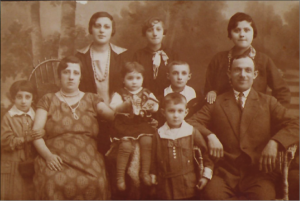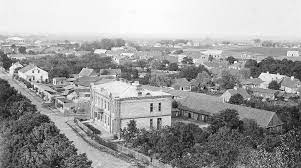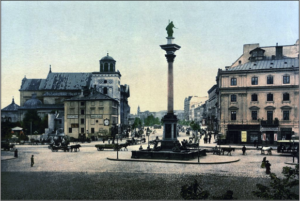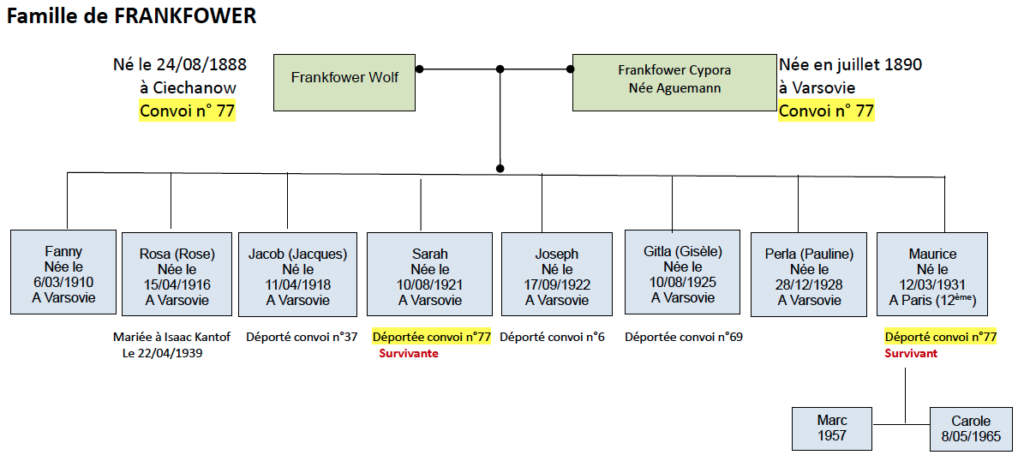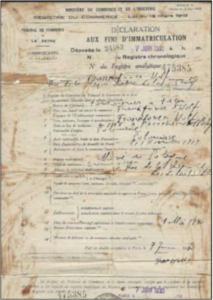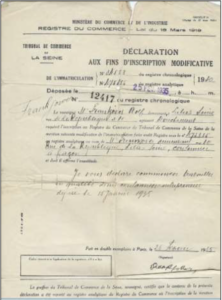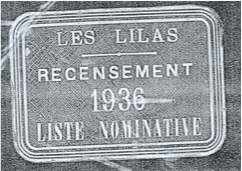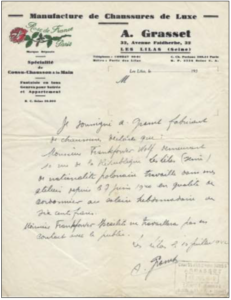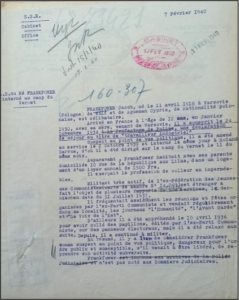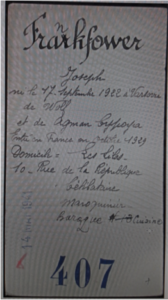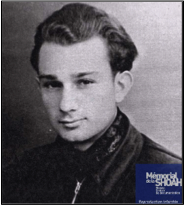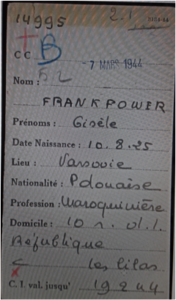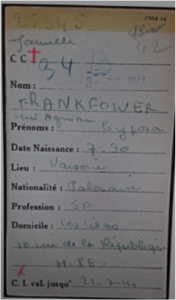Wolf FRANKFOWER
This biography was researched and written by the 9th grade students of the “Badinter” class at the Marais de Villiers middle school in Montreuil-sous-Bois, in the Seine-Saint-Denis department of France, with the guidance of their history and geography teacher, Claire Bertrand.
We initially began the project during the 2019-20 school year, but the COVID-19 epidemic stopped us in our tracks. At that time, we had very few resources available to us. During the 2022-23 school year, therefore, the project was relaunched, with the aim of gathering together additional records and searching for any possible descendants. Having written a Facebook message to everyone we could find with the name Frankfower in June 2022, Carole, the daughter of one of the survivors, contacted us in August that year. With the extra records and Carole’s help, our task became easier, although there still remain a few unresolved issues.
We are delighted to be able to share our work with you here.
A family of Polish descent
Fanny – Rosa – Sarah
Gitla – Gypojiale (the mother) – Perla – Jacob – Wolf (the father)
Joseph
Source: Family photo kindly provided by Carole Frankfower, Wolf and Gypojiale’s granddaughter
Taken in around 1930-1931
Wolf Frankfower was born on June 24, 1888 in Ciechanow (also spelled Créchanow on some records), a small town of around 5,000 people some 50 miles north of Warsaw. His parents were Samuel and Freja Bicaze, both of whom were Polish citizens and Jewish.
The town of Ciechanow in around 1910
Source
Wolf met and fell in love with Gypojiale Aguemann, who was born in Warsaw on June 28, 1890. Her parents were Radine and Bassa Crikman. Wolf and Gypojiale (again, the spelling varies) were married on March 28, 1909, also in Warsaw.
The town of Warsaw in around 1900
Source: vanupied.com
The couple had eight children, seven of whom were born in Warsaw: Fanny, on March 6, 1910; Rosa, on April 15, 1916; Jacob (Jacques), on April 11, 1918; Sarah, on August 10, 1921; Joseph, on September 17, 1922; Gitla (Gisèle), on August 10, 1925; and Perla (Pauline, Paulette) on December 28, 1928.
Their last child, Maurice was born in the 12th district of Paris on March 11, 1931.
The move to France
Wolf Frankfower moved to France on November 26, 1929. He arrived legally, having been granted a visa. We are not sure whether the rest of the family arrived at the same time as the father, and nor do we know what prompted the Frankfowers to leave their homeland. We wonder if they were victims of pogroms, or living in poverty.
Source: French National Archives, Pierrefitte.
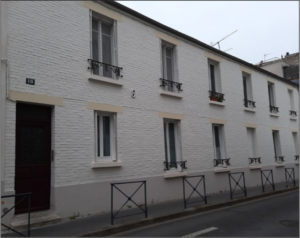
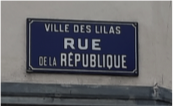
Photograph taken in December 2022 by Claire Bertrand
The family set up home at 10 rue de la république in Les Lilas, a working-class neighborhood of single-story brick houses. They were designed by the architect Emile Cacheux, a French public housing specialist. The houses he designed were built in the 1870s.
A few months after he arrived in France, Wolf became a shoemaker He registered on May 1, 1930 and the Commercial Court officially declared him as such on June 7, 1930. A second declaration, made in February 1935, confirmed that he was an independent shoemaker.
Source: Carole Frankfower’s personal records
It was in this blue-collar environment that the family’s last child, Maurice, was born in March 1931.
According to the 1936 census of Les Lilas, the entire Frankfower family, with the exception of the eldest child, Fanny, all lived in the same small, working-class house. They were still there during the Occupation, when some of the family were arrested, victims of the French government’s wartime policies (more on this later).
Les Lilas municipal archives
It appears that by April 1934, the family had decided to make France their permanent home, as Wolf Frankfower applied for French citizenship for himself and his wife.
The application was turned down, although there was no shortage of evidence of their willingness to integrate into French life. As shown on the 1936 census list, the children’s first names were all changed to similar French names. For example, Jacob became Jacques, Gitla became Gisèle and Perla was called Pauline.
Then, on September 2, 1939, with the outbreak of war in Europe after Nazi Germany invaded Poland, Wolf Frankfower volunteered to join the French army, despite the fact that he was 51 years old. This too showed his commitment to France.
Source: French National Archives, Pierrefitte
Life during the German Occupation
Wolf and his family remained in their home in Les Lilas. The Vichy government’s anti-Semitic policies introduced as of October 1940, meant that the father of the family could no longer continue to work.
Source: record kindly lent to us by Carole Frankfower
Having been registered as an independent shoemaker in 1935, he went on to work as a salaried employee in a shoe factory in Les Lilas. Was Wolf Frankfower forced to abandon his business, and were his assets confiscated, as happened to all Jewish business owners at the time? According to this record, the company had employed Wolf even before the French Republic came to an end. Then again, in the same letter, the company manager was quick to guarantee that his new employee would have no contact with the public, as required by the French government, due to his being an “israélite” (Jewish).
Despite being a foreigner and a Jew, Wolf Frankfower was “protected” because the German authorities needed skilled workers, as shown by the following record from 1943. He worked as a “fur cutter” in the “Pelta” factory in the 10th district of Paris, an held a work permit valid until August 25, 1944. We mention this date because it is very significant. We shall come back to this later.


Source: French National Archives, Pierrefitte.
As regards the children’s education, we were unable to find out any information about this.
Arrests and deportation
Between 1940 and 1944, despite being fairly well “protected’, the family came under threat from the French government’s anti-Semitic policies and due to their political activities. First of all, in September 1939, Jacques (Jacob) was arrested for his militant Communist activities, which were deemed dangerous. He was then interned in the Vernet camp in the Pyrenees from October 1939 through September 1942, prior to being deported on Convoy 37 to Auschwitz, where he died.
Source: French National Archives, Pierrefitte
Joseph was the next to be arrested. On May 14, 1941, he was arrested during the “green ticket roundup”, which targeted foreign Jewish men. He was interned at Pithiviers, then transferred to Drancy camp, from where he was deported on Convoy 6 on July 17, 1942. He too died in Auschwitz.
Source: Shoah Memorial, Paris
Next came Gitla (or Gisèle), an apprentice leatherworker, who was arrested and interned in Drancy on February 19, 1944 until March 7, when she was deported on convoy 69. She never returned home.
Source: Shoah Memorial, Paris
The Frankfower family was gradually decimated by the Vichy government’s anti-Semitic policies. Four more members of the family were arrested in July 1944, just as the Allies were liberating northern France following the Normandy landings. Wolf, Gypojiale (Cypora) and two of their children, Sarah and Maurice, the youngest child, were rounded up.
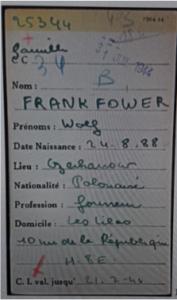

Source: Shoah Memorial, Paris
Wolf must have hoped that the work permit issued by the German authorities, which was due to expire on August 24, 1944, would help protect his family. However, despite holding the permit, Wolf, his wife and their daughter Sarah were arrested at their home in Les Lilas on July 21, 1944 and taken to Drancy. As for Maurice, he was not at home at the time. According to the testimony of his daughter, who we were able to track down, her father had not been living with his parents for some time due to the ongoing danger. The boy had been placed in the care of the UGIF (Union générale des Israélites de France or General Union of French Jews) and was staying at the residential vocational school on rue des Rosiers in Paris. The registration form completed when Maurice arrived at Drancy says that he was arrested during a round-up at the UGIF center on rue Secrétan. However, further research revealed that Maurice Frankfower was not on the list of children who were rounded up there. He must have been one of the other children arrested on the same day and taken to Drancy all together.
Source: Register from the ORT vocational school on rue des Rosiers, which was also a UGIF home
On July 22, 1944, during one of the last major roundups organized by the SS officer Aloïs Brunner, commander of the Drancy camp, the French police arrested Maurice and took him, together with a number of other children from the UGIF homes in and around Paris, to Drancy, where he was reunited with his sister Sarah and his parents. We can only imagine the parents’ dismay at meeting up with their young son in such desperate circumstances. According to the Drancy registration records, the family members were all assigned to the same staircase and room number (3.4), but later then moved and split up. Sarah and Cypora appear to have stayed together in building 4.2, while Maurice and his father appear to have been separated and put in buildings 6.4 and 4.3 respectively. Ten days later, all four were deported on the last transport from Drancy, Convoy 77, which left for Auschwitz-Birkenau on July 31, 1944.
Separated from their children, Wolf and Cypora were murdered in the gas chambers of the Auschwitz killing center. They left their homeland in the hope of a better life in France, the country on which they had pinned so many hopes for themselves and their children and “the land of human rights” for so many of the migrants who had moved in France. They were sent back to their native Poland to die, simply because they were Jewish.


 Français
Français Polski
Polski
